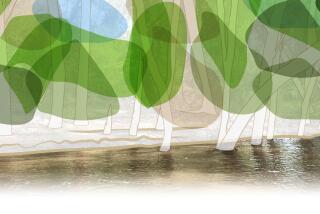Going With the Flow, as River Trek Leads Him on Adventure
The mere word âAppalachiaâ summons up a multitude of associations and images: coal miners, hillbillies and bluegrass music; the ballet by Aaron Copland and Agnes de Mille; the fiction of Bobbie Ann Mason, Chris Offutt, Denise Giardina, John Ehle and Charles Frazier; misty mountains, deep forests and rushing streams; Daniel Boone crossing the Cumberland Gap. And, according to Noah Adams, ever since the film of James Dickeyâs novel âDeliverance,â with its harrowing scene in which a suburban rafting enthusiast is raped by a mountain man, many people now think of it as a place to be avoided at any cost. But for Adams, born in a mill town in eastern Kentucky at Appalachiaâs edge, it is a place to be revisited and explored anew.
*
In âFar Appalachia,â the affable host of National Public Radioâs âAll Things Consideredâ tells of his travels by bicycle, jeep, canoe and whitewater raft along the course of the New River, which rises in the mountains of western North Carolina, flows north and east across the border into Virginia, and continues north with a slight bend west, into West Virginia, where it finally disappears into the Ohio River.
As he wanders and backtracks through three states, he encounters all sorts of things from an outdoor baptism to a fiddlersâ convention. Whether recounting the tensions and thrills of whitewater rafting or the less dramatic, yet in many ways more unsettling, experience of being overtaken by sudden rain while bicycling, Adams describes his adventures in the kind of vivid detail that provides readers with just the right sort of vicarious pleasure.
*
Even the simplest moments come alive: âI eased my canoe down off the bank and kept a hand on it as it trembled in the water. The river was cold, murky green under the clouds. A dripping step over the gunwale and I settled in, kneeling, with my back against the center thwart. The boat rocked, then steadied, and the current caught the bow and turned it downstream. Then a touch with the paddle to add some speed. This is the moment of grace. There is a hushed rippling as the water carries you away and you feel as if you could look back at the bank and see yourself as a faint tracing in the air.â
Not content with enjoying the river from his canoe, Adams decides to experience it firsthand as well: âI waded in and let the coolness travel up my legs. Then a gasping dunk so I could taste the water and hear the current burble past my ears. I pointed my feet downstream and floated--from rock, to ledge, to pool.â
*
Like any good reporter, Adams keeps his eyes and ears open, not only to the changing landscape and the remarkable variety of people he meets, but even to the wealth of flora and fauna, both terrestrial and aquatic. Although much of the pristine beauty of this region has been eroded by industry, there are still places so beautiful that some homeowners buy viewsheds: âLetâs say you build a house here,â explains one of his river guides. âYou have a nice view of the water, looking west. And you can see that mountain from your front porch . . . nothing but the trees and those pastures. . . . You want to be sure nothing happens to that part of the mountain so you go find the guy who owns itâ and pay him $50,000 for a âviewshed easementâ for 50 years, guaranteeing that neither he nor his heirs can change that side of the mountain.
Some of the most fascinating stories Adams tells involve the regionâs history. Captured by Shawnee Indians in 1755, Mary Draper Ingles had been among the first settlers to cross the Cumberland Gap. Amazingly, she managed to escape, making her way back home along the river through 500 miles of wilderness. Another woman who had escaped with her perished along the way, but not before going mad and trying to eat Mrs. Ingles! Even more chilling is the story of the West Virginia miners who died of silicosis in the 1930s, working for a giant corporation that did everything it could to deny the dangers. The one real fault of âFar Appalachia,â if there is one, is that it only skims the surfaces of these and other stories, leaving us wanting a whole lot more.
More to Read
Sign up for The Wild
Weâll help you find the best places to hike, bike and run, as well as the perfect silent spots for meditation and yoga.
You may occasionally receive promotional content from the Los Angeles Times.






